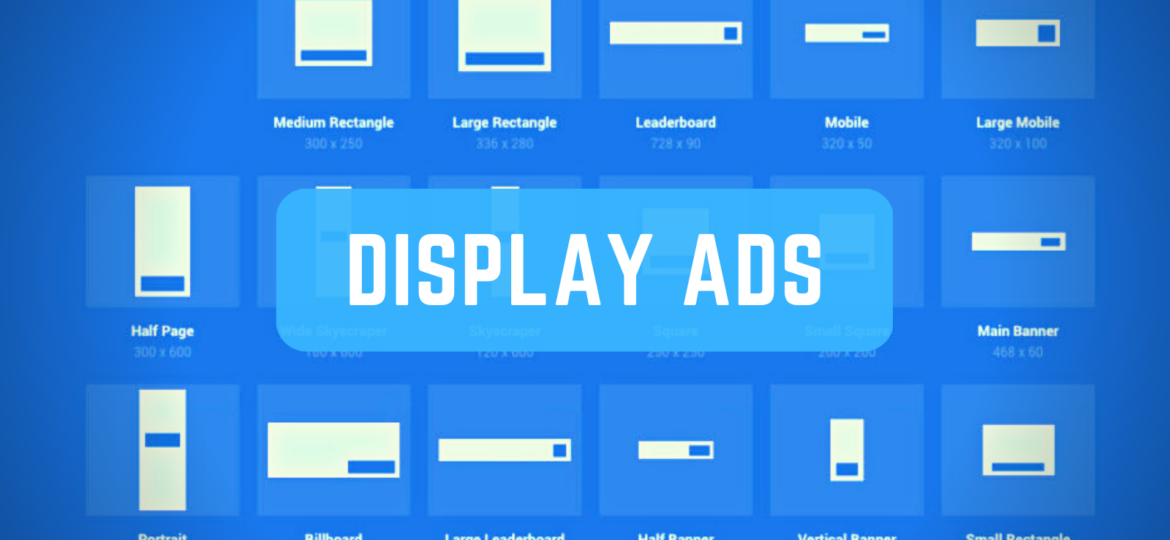
Last Updated on January 19, 2023 by anytimedigital
Are you looking to expand your digital advertising strategy and reach a wider array of prospects? Capturing the attention of online users is essential in today’s rapidly evolving digital marketing landscape. Therefore, making display ads and their design an important part of your overall ad strategy. Good display ads are not only aesthetically pleasing, but also engage viewers with creative messaging that resonates with them. This blog post will cover key principles for crafting appealing, effective digital display ads. In addition, it will include color theory, typography, layout principles and more. So if you’re looking for tips on creating stunning display banner ads that get results, read on!
How Digital Display Ads work
Display ads are digital advertising banners that display on webpages to generate awareness and engagement to reach potential users. They often display as graphical banners with animations and images, designed to capture user attention. In addition, it drives them to take action (purchase a product, or read more information). Display ads are available from many networks including Google’s display network. It allows publishers to display ads across their platform. Also, it makes use of its sophisticated targeting capabilities for maximum ROI. Additionally, display advertising can be done on other popular display networks such as Microsoft-owned auctions, LinkedIn Ads Manager and the Yahoo! Bing Network. And, placed across all devices with just one budget.
From an advertisers perspective, display ad campaigns work in a similar way where you create multiple individual display ads with different messages. They can be based on target markets which have already been set up. Furthermore, the network then places your display ad in appropriate places based on an impression fee. Therefore, you will have placement of your ads until it reaches your total budgeted amount. Overall, these display networks provide great opportunities for marketers and advertisers alike. As a result, allowing them to expand their reach into new customer demographics. And, interact directly with customers through elements making it easier to track results.
Essential Design Principles for Creating Appealing Display Banner Ads
Crafting display banner ads that will capture attention and drive potential customers to take action is no easy task. However, there are some essential design principles which can be used to ensure a successful display ad campaign. The five most important principles for creating appealing display banner ads are layout, relevancy, visibility, quality images, and consistent branding.
Layout
Layout is an essential design principle to consider when crafting display banner ads. It’s important because it serves as the foundation for organizing content and various visuals in a way that’s appealing, enhancing the user experience. A good layout will make display ads more efficient at getting their message across. Therefore, boosting its chances of making a stronger impact with potential customers. For example, it’s important to create display ads with an open flow from one image or piece of text to the next. This can be done by including directional arrows or line elements between frames. In addition, a clear hierarchy of visuals and messages.
Relevancy
Relevancy is another one of the most important design principles when crafting digital display banner ads. When content speaks to the user in a familiar context, the ad enhances customers’ experiences with the brand. As a result, encouraging them to take action. A display ad that is relevant to viewers will gain more traction than one with irrelevant content or features. For instance, relevancy can be achieved by keeping the layout clutter-free. In addition, using language that relates to your target audience, and utilizing fonts and colors relevant to the message you are trying to communicate. Finally, highlighting any points of difference from competing ads. Another important factor is that display ads should appear natively on publisher sites. Therefore, they don’t look forced or out of place in order to inhibit any disruption. Relevancy leaves a lasting impression that resonates with prospective clients.
Visibility
Ensuring elements are visible will make a huge difference in whether the display ad elicits reactions or is ignored altogether. Therefore, it’s important to create a unified design ensuring everything is easy to read and clickable. A good way to provide visibility is through color contrast. Strong colors such as black, white, red and orange help draw attention more than shades of grey or brown. Additionally, matching colors according to brand strategy will help establish recognition within the display ads universe.
It’s also important to choose fonts and sizes that stand out against the ad’s background. Therefore, making it easier for readers to focus on the display banner’s message without getting distracted. Also, it’s important to keep the display banner simple. This includes using no more than two or three colors rather than overly decorated designs. Action verbs within display banners also helps with visibility. For example, instead of static phrases like “introducing XYZ”, cues such as “try XYZ now” can help viewers to take action quickly.
Quality Images
Consistent Branding
At the heart of appealing display ads is the essential design principle of consistent branding. Digital display ads allows businesses to connect with potential customers and build brand recognition. However, without a consistent brand identity, companies risk becoming the same from one another at best and off-putting at worst. The importance of having consistent branding begins by describing clearly what your business is about. Display ads should not just be visually enhanced messages, but a symbol of your brand identity throughout. This unifies them in terms of color, font choice and imagery to ensure viewers can identify a company’s display ad instantly. Furthermore, setting them apart from competitors’ communications. With this strategy in place, creating display ads that draw attention and evoke emotion becomes much easier. It’s all about showing viewers who your business is, and why they should pick you over others in the industry.
Grabbing Viewers’ Attention and Bringing in Sales
Every business needs to find ways to get potential customers’ attention and boost their sales. Digital display banner ads is a great strategy for this because they allow businesses to spread awareness of their products quickly and cost-effectively. By creating visual messages that are strong, businesses can capture viewers’ attention and bring in more sales. For example, successful companies that have done this include Apple’s display ad campaign focused on the iPhone XR. This included a colorful design featuring bright shapes and outlines. Secondly, Adidas’ display ad campaign highlighting the company’s new Ultraboost line featured vibrant colors and graphics. Finally, remember Target’s display ad campaigns centered around their holiday season sale displaying festive imagery? Each of these display ads connected with customers in an engaging way. Therefore, inspiring them to take action.
Understanding Color Theory in display ads
Color theory is the art and science of mixing colors to create pleasing combinations for use in various visual applications. Display ads being a prime example. To help you understand color theory better and make the best display ads possible, here are five things you should consider:
Hue
Value
Tone/Saturation
Contrast
Temperature
Temperature, an often overlooked aspect, is essential when it comes to creating a display ad that packs a punch. Simply put, temperature is the measure of how warm or cool a color appears to be. For instance, white as the “coolest” and black as the “hottest”. Color theorists agree that temperature should be taken into account when designing digital display ads. For example, combining warm tones such as orange and red in with cooler tones such as blues and greens creates a vivid contrast. As a result, drawing viewer’s eyes to the display ad.
Mastering Typography in display ads
Mastering typography with digital display banner ads is an essential skill for marketers and businesses alike. This form of display ads uses text, graphics, and other visuals. Often times, the display ad must contain a large amount of text that needs to be crafted in a visually appealing way as well as easy to read. Mastering typography requires knowledge of the different elements you can use in displays. For example, font size and family, leading (the space between lines), line length and tracking (space between characters).
Examples of typography include display ads that are ordered logically with hierarchy. And, clearly have different headings from body copies using font sizes. Moreover, they should be consistent across all platforms it appears on, be it web or mobile devices. Furthermore, font styles should stay current yet legible across various sizes. Last but not least, display ads should adhere to a logical grid system when laying out elements like buttons and text fields while keeping a pleasing look.
Making Complex Display Ads Easier to Understand
Display ads can be complex. Fortunately, there are some tips that you can use to make them easier to digest. The most important tip is to keep it simple. Use a straightforward design and include only the essential information. Therefore, avoid jargon, long paragraphs of text, and unnecessary images. First, start with a universal concept. Aim for concepts that are understood across all languages and design them with simple graphic icons. Second, focus on fewer campaign messages and keep it minimal. Therefore, prioritize one major message over numerous minor ones. And, use no more than three colors as part of your display ad’s visual identity. Finally, make sure your ad appeals to its intended audience. Research the demographics of your target audience and ensure that you tailor your ads accordingly. Following these simple tips will help ensure the success of your message.
Test Your Display Ads for Optimal Performance
Testing display ads for optimal performance is essential to the success of any online ad campaign. Some key components that need to be tested include display size, animations, colors, font size and style, and CTA positioning. To run an effective test, it is advised to set up a/b tests where you can compare two sets of ads and measure results. This can be based on KPIs like impressions and conversions. Therefore, identifying which type works better for your target audience.
There are a range of tools available that could help you with display ad testing. For example, Heatmaps, Google Optimize, UserTesting.com and Visual Website Optimizer. Heatmaps provide useful information about how viewers interact with your display ad across different devices. This includes whether they viewed all sections of the ad and where their eyes focused depending on the type or size. With testing metrics like heatmap analysis, you gain clear insights into how different elements affect user engagement. Additionally, tools like UserTesting enable customers to test their ads while simulating user conditions on their targeted browsers. This allows to discover potential issues with animations or colors. Finally, it’s important to factor customer feedback than simply testing for metrics alone.
The Benefits of Creating Attractive Digital Ads
Creating attractive digital display ads is an integral part of many businesses as it can bring numerous potential benefits. Firstly, the use of visuals, easy text and powerful calls to action can draw customers in and lead to more sales. Additionally, they can enhance branding in a cost-effective manner. With consistent visuals, display ads create a unified look for the business which further impresses potential customers. Furthermore, attractive display ads lets businesses have a greater impact on their target audience. It establishes a more professional outlook for practices like online advertising. By investing in good ad design, businesses will appear polished which lends credibility to any business venture.




